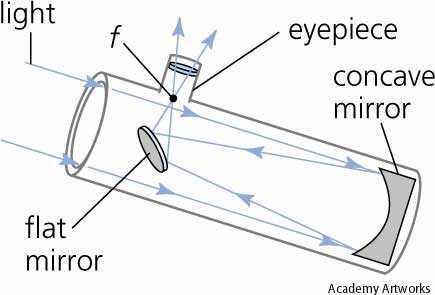Lenses
Lenses come in many different shapes and sizes; convex, concave, mirrored, biconvex, biconcave.. The list goes on and on.
These are bits of plastic or glass (that are obviously see through) that manipulate light into being magnified. Think of it like a toll-gate on a road, all the cars branch into one road (just like light). We can use this property to help us fulfil our needs.
Focal points and lengths
Lenses have focal points. This is the point the light gets refracted to. Again with the toll gate situation, think of where the road starts again after the branch off. The focal point is where the image is the clearest.
Focal lengths are the distance from the lens to the focal point.
As you get further away from it, the image gets bigger but also more blurry (less clear). An image on the right will help you understand this a bit better!
Telescopes
Most telescopes nowadays are categorised into two groups: Refractors and Reflectors.
Bit self explanatory, refractor telescopes reflect light (like the toll gate situation I explained earlier). Reflector telescopes reflect light by gathering and focusing it to a single point. Reflectors are a bit more complicated but we'll go into that later on!
Telescopes use 2 main lenses, the objective lens and the eyepiece.
Galileo often claims credit for making the first telescope, but wait! It wasn't him.. He was the first to use it for astronomy. The clever dude who invented refractor telescopes was a guy from Holland called Hans Lippershey.
.jpg/220px-Chromatic_aberration_(comparison).jpg) The objective lens (the massive one at the front) gathers all the light and refracts it to a single point near the back of the tube. The eyepiece projects this light into your eye and you see zoomed up images. The eyepiece has a much shorter focal distance (why you have to be right next to it to see).
The objective lens (the massive one at the front) gathers all the light and refracts it to a single point near the back of the tube. The eyepiece projects this light into your eye and you see zoomed up images. The eyepiece has a much shorter focal distance (why you have to be right next to it to see).
However Refractors have chromatic aberration, which is a really annoying rainbowy effect on edges.
Newton (THE Isaac Newton) created the Reflector telescope to solve this!
Reflectors
 Reflecting telescopes are more complicated. Because of the annoying chromatic aberration, Newton used a curved mirror to solve the problem (because mirrors don't refract light, so no rainbow). This curved mirror again reflects to a focus.
Reflecting telescopes are more complicated. Because of the annoying chromatic aberration, Newton used a curved mirror to solve the problem (because mirrors don't refract light, so no rainbow). This curved mirror again reflects to a focus.
Because the mirror reflects some light into the tube, a second small mirror is added on the side so light is reflected back in.
Magnification and Resolution
Don't get confused with the two!
- Magnification is how far from the focal point. So the closer, the less zoomed in but the better the resolution (the clearness).
- The Resolution is how clear, so how close to the focal point. You have to find a compromise between the two. But if you want a lot of both it gets very expensive.. Take the Hubble telescope, I don't think you can cover that with your Saturday job!
More stuff on lenses..
Your eyes
Your eye is a lens, but all light going in refracts upside down so technically your seeing everything upside down. Your brain though is clever enough to flip it so it's all upright!
Bare in mind this is at your own expense, I don't dare try it myself.
- Create some glasses
- Make mirrors reflect things upside down so you see stuff upside down
- Wear it non-stop from 3-5 days
- Your brain will flip it so it's upright
- Take glasses off, everything should be upside down!
If you do the experiment, tell me what happens! I don't want to do it in case everything is upside down permanently and get hit by an upside down car..




No comments:
Post a Comment